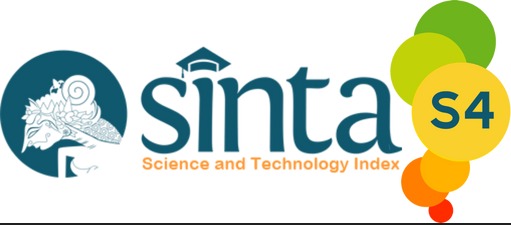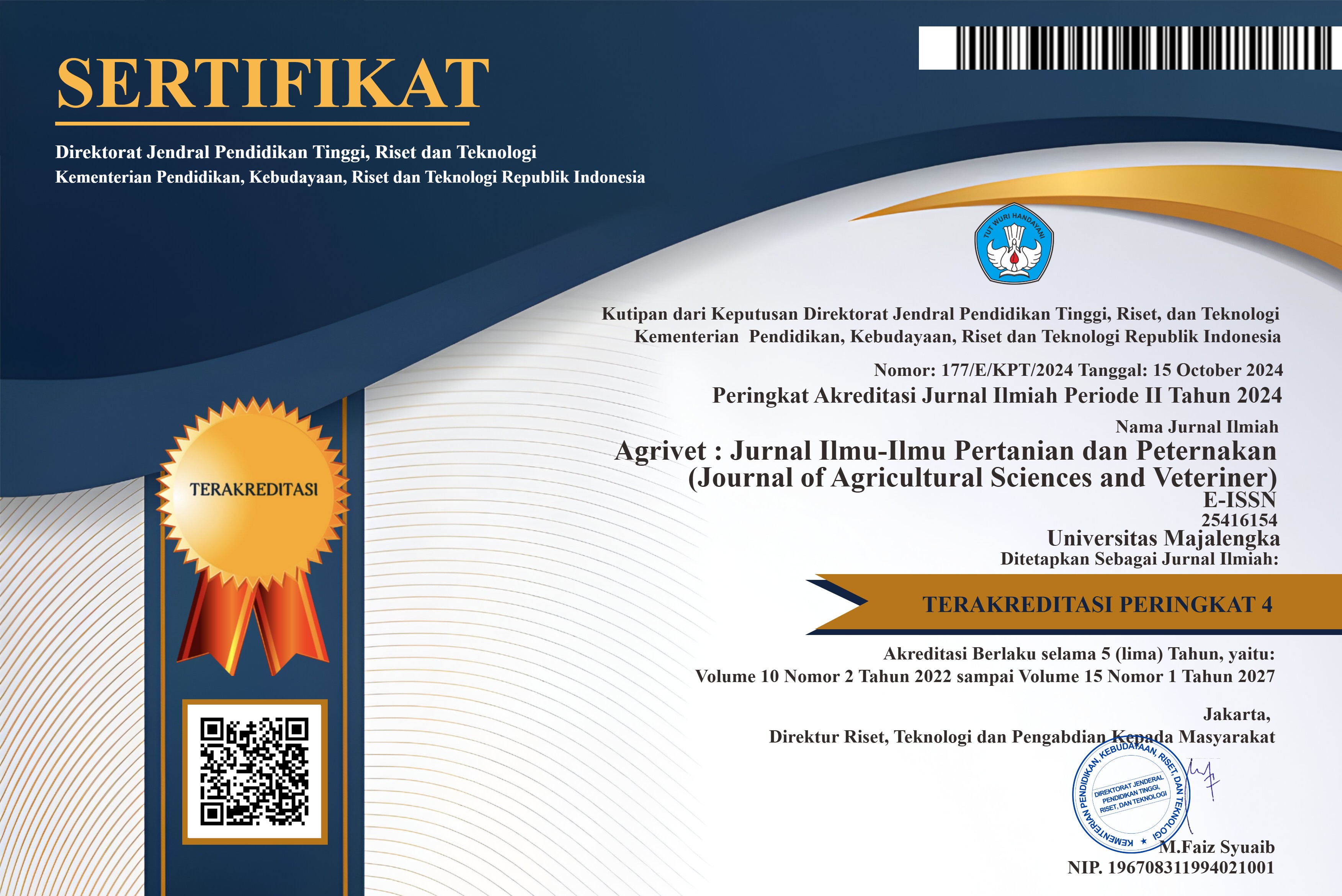Pengaruh herbisida bentazon 400 g/l + mcpa 60 g/l terhadap gulma, pertumbuhan dan hasil tanaman padi (Oryza sativa L.)
DOI:
https://doi.org/10.31949/agrivet.v11i2.6458Abstract
Weeds are one of the obstacles in rice cultivation because they can reduce rice yields both in quality and quantity. Weeds compete in terms of necessities of life such as water, nutrients and sunlight. This study aims to determine the effect of betazon 400 g/l + MCPA 60 g/l in controlling weeds and the growth of paddy rice. The research was conducted in Palasah Village, Kertajati District, Majalengka Regency, West Java. The experiment used a one-factor Randomized Block Design (RBD) with seven treatments and four replications. The experiment consisted of five treatments of bentazone 400 g/l + MCPA 60 g/l at a dose of 1.5 L/ha, 2.0 L/ha, 2.5 L/ha, 3.0 L/ha, 3.5 L/ha, the comparison is in the form of manual control and without weed control. The data obtained if there is a significant difference will be further tested using the testDuncan Multiple Range Test (DMRT) at the level of 5%. The results showed that the application of the herbicide Bentazone 400 g/l + MCPA 60 g/l at a dose of 1.5 L/ha was able to suppress the growth of broadleaf weeds (Lindernia crustarcea, Spenoclia zeylanica and Marsilea crenata), sedge weeds (Cypress iria and Fimbristylis miliacea) and does not cause symptoms of toxicity (phytotoxicity) to rice plants which so that they do not interfere with their growth.
Keywords:
Bentazon 400 g/l MCPA 60 g/, Weeds, Rice FieldDownloads
References
Aditya, R. D. (2021). Herbisida : Risiko terhadap Lingkungan dan Efek Menguntungkan. Sainteknol, 19(1). https://journal.unnes.ac.id/nju/index.php/sainteknol
Allifah AF, A. N., Rosmawati, R., & Jamdin, Z. (2019). Refugia Ditinjau Dari Konsep Gulma Pengganggu Dan Upaya Konservasi Musuh Alami. Biosel: Biology Science and Education, 8(1). https://doi.org/10.33477/bs.v8i1.849
Badan Pusat Statistik. (2022). Luas Panen dan Produksi Padi di Indonesia 2021 (Angka Tetap). Badan Pusat Statistik , 1–20.
Badan Pusat Statistik. (2023). Rata-rata Konsumsi Perkapita Seminggu Menurut Kelompok Padi-Padian Per Kabupaten/kota (Satuan Komoditas). https://www.bps.go.id/site/resultTab
Budhiawan, A., Guritno, B., Agung, D., Jurusan, N., Pertanian, B., & Pertanian, F. (2016). Aplikasi herbisida 2,4-D dan Penoxuslam pada pertumbuhan dan hasil tanaman Padi Sawah (Oryza sativa L.). Jurnal Produksi Tanaman, 4(1).
Dani, U., Sumekar, Y., Widayat, D., & Arifin, M. (2023). Efektifitas Herbisida Pirazosulfuron Etil terhadap Gulma serta Pengaruhnya terhadap Pertumbuhan dan Hasil Padi Sawah (Oryza sativa L.). Jurnal Agroteknologi Tropika Lembab, 5(2), 143–151. https://doi.org/DOI.210.35941/JATL
DiTomaso, Joseph. M. (2011). Mode of Actions of the Growth Regulator Herbicides.
Gunarsih, C., Nafisah, & Sitaresmi, T. (2016). Pembentukan varietas padi sawah dataran tinggi toleran cekaman suhu rendah. Iptek Tanaman Pangan, 11(2).
Gunsolus, Jeffrey. L., & Curran, William. S. (2002). Herbicide Mode of Action and Injury Symptoms.
Jaisyurahman, U., Wirnas, D., Trikoesoemaningtyas, & Purnamawati, H. (2020). Dampak Suhu Tinggi terhadap Pertumbuhan dan Hasil Tanaman Padi. Jurnal Agronomi Indonesia (Indonesian Journal of Agronomy), 47(3). https://doi.org/10.24831/jai.v47i3.24892
Manik, T. K., Sembodo, D. R., & Saputra, D. (2020). Effect of Rainfall Intensity on Glyphosate Herbicide Effectiveness in Controlling Ageratum conyzoides, Rottboellia exaltata, and Cyperus rotundus Weeds. Agromet, 34(1). https://doi.org/10.29244/j.agromet.34.1.11-19
Nafisha, A. U., & Suwarsito. (2018). Kajian Pengaruh Pola Curah Hujan terhadap Produktivitas Padi di Kecamatan Pagerbarang Kabupaten Tegal. Jurnal Nasional Sainteks, 15(1), 31–37.
Paiman. (2020). Gulma Tanaman Pangan (P. Yudono, Ed.; 1st ed., Vol. 7). UPY Press.
Paski, J. A. I., S L Faski, G. I., Handoyo, M. F., & Sekar Pertiwi, D. A. (2018). Analisis Neraca Air Lahan untuk Tanaman Padi dan Jagung Di Kota Bengkulu. Jurnal Ilmu Lingkungan, 15(2). https://doi.org/10.14710/jil.15.2.83-89
Polansky, S., & Guntoro, D. (2016). Pengendalian Gulma pada Tanaman Padi Sawah dengan Menggunakan Herbisida Berbahan Aktif Campuran Bentazon dan MCPA. Buletin Agrohorti, 4(1). https://doi.org/10.29244/agrob.v4i1.15011
Pramasani, E. M., & Soelistyono, R. (2018). Dampak perubahan iklim terhadap perubahan musim tanam Padi (Oryza sativa L.) di Kabupaten Malang. Plantropica Journal of Agricultural Science, 3(2).
Ruminta, R., Handoko, H., & Nurmala, T. (2018). Indikasi perubahan iklim dan dampaknya terhadap produksi padi di Indonesia (Studi kasus : Sumatera Selatan dan Malang Raya). Jurnal Agro, 5(1). https://doi.org/10.15575/1607
Saudy, H. S., El-Metwally, I. M., & Abd El-Samad, G. A. (2020). Physio-Biochemical and Nutrient Constituents of Peanut Plants Under Bentazone Herbicide for Broad-Leaved Weed Control and Water Regimes in Dry Land Areas. Journal of Arid Land, 12(4). https://doi.org/10.1007/s40333-020-0020-y
Simanjuntak, R., Wicaksono, K. P., & Tyasmoro, S. Y. (2016). Pengujian Efikasi Herbisida Berbahan Aktif Pirazosulfuron Etil 10% Untuk Penyiangan Pada Budidaya Padi Sawah (Oryza sativa L.). Jurnal Produksi Tanaman, 4(1), 31–39.
Sridevi, V., & Chellamuthu, V. (2015). Impact of weather on rice - a review. International Journal of Applied Research, 1(9).
Sudhana, A., Kawuryan, S. H. E., & Padmini, O. S. (2018). Pengaruh Aplikasi Herbisida dan PGPR Dalam Pengendalian Gulma Untuk Meningkatkan Pertumbuhan Tanaman Padi Sawah. Inovasi Pangan Lokal Untuk Mendukung Ketahanan Pangan, 1–7.
Sumekar, Y. (2022). Efektivitas Campuran Herbisida Saflufenacil 250 g/l + Trifludimoxazin 125 g/l Terhadap Gulma Pada Pertanaman Kelapa Sawit Belum Menghasilkan. Proceedings Series on Physical & Formal Sciences, 4, 453–460. https://doi.org/10.30595/pspfs.v4i.536
Sun, Y., Kaleibar, B. P., Oveisi, M., & Müller-Schärer, H. (2021). Addressing Climate Change: What Can Plant Invasion Science and Weed Science Learn From Each Other? In Frontiers in Agronomy (Vol. 2). https://doi.org/10.3389/fagro.2020.626005
Syuhada, S., Erida, G., & Hasnuddin, H. (2018). Pengaruh Jenis dan Dosis Mulsa Terang Bulan dan Kirinyuh Terhadap Pertumbuhan Gulma pada Tanaman Kedelai (Glycine max L.). Jurnal Ilmiah Mahasiswa Pertanian, 3(4). https://doi.org/10.17969/jimfp.v3i4.9390
Widaryanto, E., Saitama, A., & Zaini, A. H. (2021). Teknologi Pengendalian Gulma (Tim UB Press, Ed.; 1st ed., Vol. 12). UB Press.
Published
How to Cite
Issue
Section
License
Copyright (c) 2023 Yayan Sumekar, Rian Suryana, Acep Atma Wijaya, Umar Dani

This work is licensed under a Creative Commons Attribution-ShareAlike 4.0 International License.
An author who publishes in the Jurnal Agrivet agrees to the following terms:
- Author retains the copyright and grants the journal the right of first publication of the work simultaneously licensed under the Creative Commons Attribution-ShareAlike 4.0 License that allows others to share the work with an acknowledgment of the work's authorship and initial publication in this journal
- The author is able to enter into separate, additional contractual arrangements for the non-exclusive distribution of the journal's published version of the work (e.g., post it to an institutional repository or publish it in a book) with the acknowledgment of its initial publication in this journal.
- The author is permitted and encouraged to post his/her work online (e.g., in institutional repositories or on their website) prior to and during the submission process, as it can lead to productive exchanges, as well as earlier and greater citation of the published work












